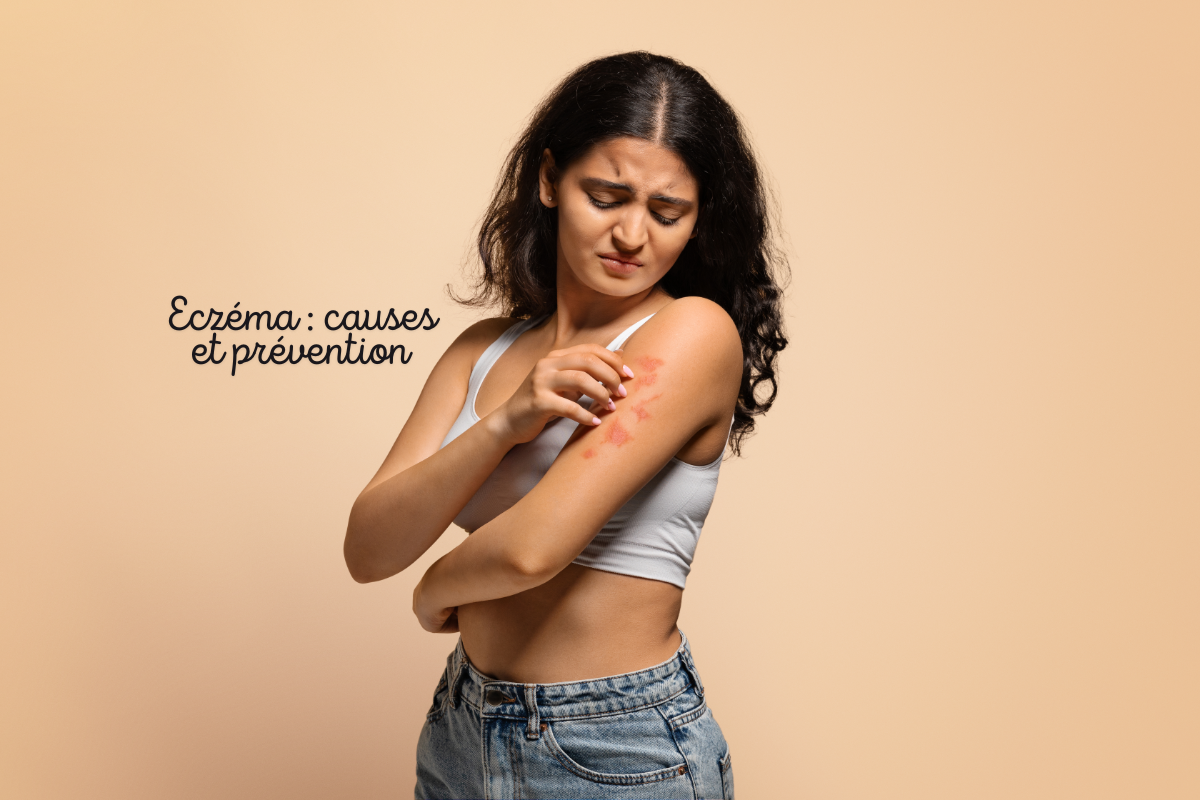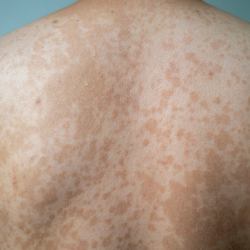Eczema refers to a group of inflammatory skin conditions that cause redness, itching and sometimes lesions. The most common type, called atopic dermatitis, is not contagious.
Although its precise causes remain poorly understood, specialists agree that it involves a complex interaction between a genetic predisposition and environmental factors. This over-reaction of the immune system leads to an alteration in the skin barrier, making the skin more vulnerable to irritants, allergens and infections.
What are the underlying causes of eczema and how does it develop?
Atopic dermatitis is a chronic condition that affects the skin deep down. It manifests itself in intense itching, persistent inflammation and damage to the skin barrier. In short, the skin no longer plays its role as a shield properly.
This condition is the result of a complex combination of genetic and environmental factors. Some people are predisposed from birth, and their symptoms are triggered or aggravated by external factors such as allergens, pollution or stress.
There are generally three phases in the development of eczema: infancy, childhood and adulthood. Clinical forms vary widely, from simple lesions on the hands to generalised eruptions such as erythroderma.
During outbreaks, red, itchy papules and vesicles are often seen. These lesions can be superinfected, particularly by bacteria such as Staphylococcus aureus, which is very common in sufferers.
What triggers eczema in susceptible people?
In eczema sufferers, the skin barrier no longer plays its protective role. It becomes permeable, allowing irritants, allergens and germs to pass through. This weakness is often linked to an exaggerated inflammatory response from the immune system, but also to a genetic mutation affecting the production of filaggrin, a protein essential to the formation of the skin’s outer layer.
Without sufficient filaggrin, the skin loses its natural moisture more easily. It then becomes dry, irritated and vulnerable to external aggression. This structural alteration encourages allergic reactions, infections and chronic inflammation.
Around 30% to 40% of eczema sufferers have an allergic form. Their immune system reacts to certain food or environmental allergens, triggering an inflammatory cascade. But it’s not always a case of allergy: things like cigarette smoke, wool, rough clothing or extreme temperatures can also irritate the skin without causing an allergic reaction.
These triggers vary from one individual to another, making diagnosis and prevention all the more complex.
What types of eczema are there and how can you recognise them?
Eczema is not a single disease, but an umbrella term for several forms of inflammatory skin conditions. Each type has its own characteristics, probable causes and areas of predilection.
Atopic eczema is the most common. Atopic eczema often starts in childhood, sometimes even in infants. It mainly affects the folds of the body – behind the knees, elbows and neck – but can also appear on the face. It is often associated with other allergic disorders such as asthma or rhinitis.
Contact eczema occurs when the skin comes into contact with an irritant or allergenic substance. A distinction is made between allergic contact eczema (immune reaction) and irritant eczema (linked to an aggressive agent). The areas affected vary depending on exposure, and symptoms include redness, burning and localised itching.
Dyshidrosis, or dyshidrotic eczema, manifests itself as small fluid-filled blisters on the hands, fingers and sometimes feet. It is often painful and can be triggered by stress or excessive sweating.
Nummular eczema takes the form of round or oval patches resembling coins. These lesions may ooze or form scabs, and are common on the legs and arms.
Seborrhoeic eczema, on the other hand, mainly affects areas rich in sebaceous glands, such as the scalp, wings of the nose or eyebrows. It is accompanied by oily scales and redness.
Varicose eczema, also known as stasis dermatitis, is linked to circulatory problems, especially in the legs. Its symptoms are thickened skin, itching and brown pigmentation.
Can you catch eczema from contact with another person?
No, eczema is not a contagious disease. It is not transmitted by touch, droplets or close contact. This inflammatory skin condition is the result of an internal malfunction of the immune system and damage to the skin barrier, often aggravated by environmental factors.
Atopic dermatitis, the most common form of eczema, is linked to genetic predisposition. However, each person reacts differently to triggers: allergens, irritants, dry or cold weather, stress, etc. Understanding one’s own triggers is the key to limiting flare-ups and better managing the disease on a day-to-day basis.
Can diet aggravate or relieve eczema?
More and more studies are exploring the links between diet and eczema flare-ups. Although each individual reacts differently, it is clear that certain foods can play a role in skin inflammation and the quality of the skin barrier.
An anti-inflammatory diet, rich in vegetables, fresh fruit, oily fish (such as salmon or mackerel), as well as flaxseed and walnuts, can help reduce symptoms. Natural probiotics, found in fermented foods such as kefir or yoghurt, also support intestinal health, which is often implicated in chronic inflammatory disorders such as eczema.
Conversely, certain foods are regularly associated with a worsening of symptoms: dairy products, refined sugar, gluten, colourings or chemical additives. These sensitivities vary greatly from person to person.
Keeping a food diary can help identify personal triggers. If in doubt, it’s best to seek the advice of a healthcare professional before embarking on a prolonged food avoidance programme.
How can I reduce the frequency of eczema flare-ups in the long term?
There are two main ways of preventing eczema attacks: protecting atopic skin and avoiding the triggers. These simple but effective measures can significantly improve day-to-day comfort.
Moisturisation is essential. Applying an emollient cream every day, especially after a shower, helps to strengthen the skin barrier and limit water loss. Bath or shower water should be lukewarm, never hot, to avoid damaging the skin.
The choice of hygiene products is also important. It’s best to opt for soap-free, superfatted cleansers that contain no perfumes or irritating preservatives. When it comes to clothing, soft fabrics such as cotton are preferable to wool or synthetic fibres.
Stress, often underestimated, is an aggravating factor. Relaxation techniques such as meditation, conscious breathing or yoga can have a positive impact.
Finally, maintaining a healthy home environment – free from excessive dust, dust mites and mould – helps to reduce skin irritation. Using a humidifier can also be helpful in dry conditions.
Does eczema disappear when I grow up, or can it return as an adult?
How eczema develops over time depends largely on the individual. For some children, symptoms gradually diminish and disappear completely by adolescence. It is estimated that around 60% of young people with moderate to severe eczema may continue to show signs of the disease into adulthood, in the form of more or less frequent relapses.
Others will see their eczema subside, only to reappear years later, often as a result of triggers such as stress, hormonal changes or extreme weather conditions.
Eczema is not considered curable, but it is entirely possible to control its symptoms. Appropriate treatment, combined with a healthy lifestyle and regular medical check-ups, can limit the number of attacks and maintain quality of life.
It is therefore important to listen to your body and consult a health professional as soon as symptoms develop or become bothersome in everyday life.
How can you recognise the triggers responsible for eczema flare-ups?
Identifying what triggers an eczema flare-up is not always easy. But it’s an essential step in adopting appropriate lifestyle habits and limiting the frequency of flare-ups.
The first thing to do is to keep a diary. Every day, write down what you eat, the products you apply to your skin, your stress levels, your activities and environmental conditions (climate, pollution, etc.). This data can reveal correlations between certain elements and the appearance of symptoms.
A medical consultation is often necessary to find out more about the triggers. Skin or blood tests carried out by an allergist can identify any allergies, whether food or environmental.
If an allergic or irritant lead is confirmed, the method of exclusion and then gradual reintroduction allows the skin’s reactions to different products or foods to be observed. This protocol must be supervised by a professional.
You should also pay close attention to your hygiene, cosmetic and household products. Many contain invisible but active irritants. It is important to choose cosmetic products for intolerant skin. Finally, emotional stress is a recognised trigger. Learning to manage it using relaxation techniques can considerably improve skin stability.





